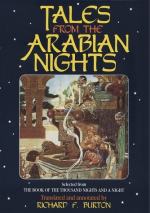[FN#248] Arab. “’Arsah,” akin to “Mu’arris” (masc.) = a pimp, a pander. See vol. i. 338; and Supp. vol. i. 138; and for its use Pilgrimage i. 276.
[FN#249] i.e. Abu Kasim the Drummer. The word “Tambur” is probably derived from “Tabl” = a drum, which became by the common change of liquids “Tabur” in O. French and “Tabour” in English. Hence the mod. form “Tambour,” which has been adopted by Turkey, e.g. Tamburji = a drummer. In Egypt, however, “Tambur” is applied to a manner of mandoline or guitar, mostly used by Greeks and other foreigners. See Lane, M.E. chap. xviii.
[FN#250] Arab. “Bal” (sing. Balah) = a bale, from the Span. Bala and Italian Balla, a small parcel made up in the shape of a bale, Lat. Palla.
[FN#251] Arab. “Walash,” i.e. “Was la shayya” = “And nihil” (nil, non ens, naught).
[FN#252] Arab. “Kurbaj” = cravache: vol. viii. 17. The best are made of hippopotamus-hide (imported from East Africa), boiled and hammered into a round form and tapering to the point. Plied by a strong arm they cut like a knout.
[FN#253] The text “Ya Sultan-am,” a Persian or Turkish form for the Arab. “Ya Sultan-i.”
[FN#254] In text “Kalb” for “Kulbat” = a cave, a cavern.
[FN#255] The houses were of unbaked brick or cob, which readily melts away in rain and requires annual repairing at the base of the walls where affected by rain and dew. In Sind the damp of the earth with its nitrous humour eats away the foundations and soon crumbles them to dust.
[FN#256] Here meaning the under-Governor or head Clerk.
[FN#257] “Nil” (= the Nile), in vulgar Egyptian parlance the word is = “high Nile,” or the Nile in flood.
[FN#258] Arab. “Darwayshsah” = a she-Fakir, which in Europe would be represented by that prime pest a begging nun.
[FN#259] Arab. “Allah hafiz-ik” = the popular Persian expression, “Khuda Hafiz!”
[FN#260] Arab. “Salihin” = the Saints, the Holy Ones.
[FN#261] Arab. “Sharkh” = in dicts. the unpolished blade of a hiltless sword.
[FN#262] In the text “Milayah,” a cotton stuff some 6 feet long, woven in small chequers of white and indigo-blue with an ending of red at either extremity. Men wrap it round the body or throw it over the shoulder like our plaid, whose colours I believe are a survival of the old body-paintings, Pictish and others. The woman’s “Milayah” worn only out of doors may be of silk or cotton: it is made of two pieces which are sewed together lengthwise and these cover head and body like a hooded cloak. Lane figures it in M.E. chapt. i. When a woman is too poor to own a “Milayah” or a “Habarah” (a similar article) she will use a bed-sheet for out-of-doors work.
[FN#263] The pun here is “Khaliyat” = bee-hive and empty: See vols. vi. 246 ix. 291. It will occur again in Supplementary vol. v. Night DCXLVI.
[FN#264] i.e. Caravan, the common Eastern term. In India it was used for a fleet of merchantmen under convoy: see Col. Yule, Glossary, s. v.




